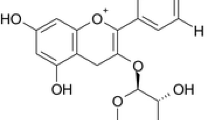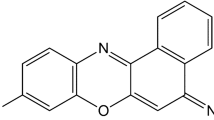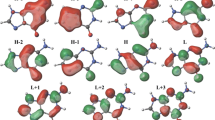Abstract
A typical quinacridone pigment, PV19, has been used to analyze the impact of several computational parameters on the UV/vis absorption band shape in solution, simulated using density functional theory and time-dependent density functional theory levels of approximation. These encompass, (i) the choice of exchange—correlation functional, (ii) the basis set, (iii) the method for non-equilibrium optimization of the excited state geometry, (iv) the approach for evaluating the vibronic band structure, (v) the peak broadening, and (vi) the scaling of the harmonic vibrational frequencies. Among these, the choice of exchange—correlation functional is certainly of the most importance because it can drastically modify the spectral shape. In the case of PV19, the M05-2X and to a lesser extent CAM-B3LYP XC functionals are the most efficient to reproduce the vibronic structure, confirming the important role of exact Hartree-Fock exchange. Still, these functionals are not the most reliable to predict the excitation energies and oscillator strengths, for which M05, a functional with less HF exchange, performs better. For evaluating the vibronic structure, the simple gradient method, where only one step of geometry optimization of the excited state is carried out and the gradients are used to evaluate the Huang-Rhys factors as well as to determine the excited state geometries produces a spectrum that is very similar to the ones obtained with the more involved Duschinsky and geometry methods, opening the way to a fast simulation of the UV/vis absorption spectra of pigments and dyes. Then, the effect of scaling the calculated vibrational frequencies to account for anharmonicity effects as well as for limitation of the method also impacts the shape of the vibronic spectrum and this effect depends on the method used to determine the Huang-Rhys factors. Indeed, scaling the vibrational frequencies by a factor which is typically smaller than 1.0 results in a relative decrease of the 0–1 peak intensity with respect to the 0–0 band when optimizing the geometry of the excited state whereas the effect is opposite and magnified if using the gradient method.
Similar content being viewed by others
References
R. J. D. Tilley, Colour and the Optical Properties of Materials, John Wiley & Sons, Chichester, 2000.
R. M. Christie, Colour Chemistry, RSC, Cambridge, 2001.
B. Mennucci, Modeling environment effects on spectroscopies through QM/classical models Phys. Chem. Chem. Phys. 2013 15 6583–6594.
C. Adamo and D. Jacquemin, The calculations of excited-state properties with Time-Dependent Density Functional Theory Chem. Soc. Rev. 2013 42 845–856.
C. Faber, P. Boulanger, C. Attaccalite, I. Duchemin and X. Blase, Excited states properties of organic molecules: from density functional theory to the GW and Bethe-Salpeter Green’s function formalisms Philos. Trans. R. Soc. London, Ser. A 2014 372 20130271.
V. Barone, M. Biczysko, J. Bloino, L. Carta and A. Pedone, Environmental and dynamical effects on the optical properties of molecular systems by time-independent and time-dependent approaches. Coumarin derivatives as test cases Comput. Theor. Chem. 2014 1037 35–48.
M. Schreiber, M. R. Silva-Junior, S. P. A. Sauer and W. Thiel, Benchmarks for electronically excited states: CASPT2, CC2, CCSD, and CC3 J. Chem. Phys. 2008 128 134110.
R. Send, V. R. I. Kaila and D. Sundholm, Reduction of the virtual space for coupled-cluster excitation energies of large molecules and embedded systems J. Chem. Phys. 2011 134 214114.
C. Faber, I. Duchemin, T. Deutsch and X. Blase, Many-body Green’s function study of coumarins for dye-sensitized solar cells Phys. Rev. B: Condens. Matter 2012 86 155315.
Y. A. Bernard, Y. Shao and A. I. Krylov, General formulation of spin-flip time-dependent density functional theory using non-collinear kernels: Theory, implementation, and benchmarks J. Chem. Phys. 2012 136 204103.
N. O. C. Winter, N. K. Graf, S. Leutwyler, C. Hättig, Benchmarks for 00_ transitions of aromatic organic molecules: DFT/B3LYP, ADC(2), CC2, SOS-CC2 and SCS-CC2 compared to high-resolution gas-phase data Phys. Chem. Chem. Phys. 2013 15 6623–6630.
R. Fukuda and M. Ehara, Electronic excited states and electronic spectra of biphenyl: a study using many-body wavefunction methods and density functional theories Phys. Chem. Chem. Phys. 2013 15 17426–17434.
X. Liu, Q. Ou, E. Alguire and J. E. Subotnik, An inexpensive, variational, almost black-box, almost size-consistent correction to configuration interaction singles for valence excited states J. Chem. Phys. 2013 138 221105.
E. Walczak, B. Szefczyk and T. Andruniow, Geometries and Vertical Excitation Energies in Retinal Analogues Resolved at the CASPT2 Level of Theory: Critical Assessment of the Performance of CASSCF, CC2, and DFT Methods J. Chem. Theor. Comput. 2013 9 4915–4927.
S. Knecht, C. M. Marian, J. Kongsted and B. Mennucci, On the Photophysics of Carotenoids: A Multireference DFT Study of Peridinin J. Phys. Chem. B 2013 117 13808–13815.
O. Valsson, P. Campomanes, I. Tavernelli, U. Rothlisberger and C. Filippi, Rhodopsin Absorption from First Principles: Bypassing Common Pitfalls J. Chem. Theor. Comput. 2013 9 2441–2454.
E. Ronca, C. Angeli, L. Belpassi, F. de Angelis, F. Tarantelli and M. Pastore, Density Relaxation in Time-Dependent Density Functional Theory: Combining Relaxed Density Natural Orbitals and Multireference Perturbation Theories for an Improved Description of Excited states J. Chem. Theor. Comput. 2014 10 4014–4024.
A. Kovyrshin, F. de Angelis and J. Neugebauer, Selective TDDFT with automatic removal of ghost transitions: application to a perylene-dye-sensitized solar cell model Phys. Chem. Chem. Phys. 2012 14 8608–8619.
S. S. Leang, F. Zahariev and M. S. Gordon, Benchmarking the performance of time-dependent density functional methods J. Chem. Phys. 2012 136 104101.
T. Petrenko and F. Neese, Efficient and automatic calculation of optical band shapes and resonance Raman spectra for larger molecules within the independent mode displaced harmonic oscillator model J. Chem. Phys. 2012 137 234107.
G. V. Lopez, C. H. Chang, P. M. Johnson, G. E. Hall, T. J. Sears, B. Markiewicz, M. Milan and A. Teslja, What is the Best DFT Functional for Vibronic Calculations? A Comparison of the Calculated Vibronic Structure of the S1-S0 Transition of Phenylacetylene with Cavity Ringdown Band Intensities J. Phys. Chem. A 2012 116 6750–6758.
B. Moore II and J. Autschbach, Longest-Wavelength Electronic Excitations of Linear Cyanines: The Role of Electron Delocalization and of Approximations in Time-Dependent Density Functional Theory J. Chem. Theor. Comput. 2013 9 4991–5003.
S. Agrawal, P. Dev, N. J. English, K. Ravindranathan Thampi and J. M. D. MacElroy, A TD-DFT study of the effects of structural variations on the photochemistry of polyene dyes Chem. Sci. 2012 3 416–424.
S. Höfener, P. C. Kooijman, J. Groen, F. Ariese and L. Visscher, Fluorescence behavior of (selected) flavonols: a combined experimental and computational study Phys. Chem. Chem. Phys. 2013 15 12572–12581.
D. Jacquemin, A. Planchat, C. Adamo and B. Mennucci, TD-DFT Assessment of Functionals for Optical 00_ Transitions in Solvated Dyes J. Chem. Theor. Comput. 2012 8 2359–2372.
A. Charaf-Eddin, A. Planchat, B. Mennucci, C. Adamo and D. Jacquemin, Choosing a Functional for Computing Absorption and Fluorescence Band Shapes with TD-DFT J. Chem. Theor. Comput. 2013 9 2749–2760.
A. Graczyk, J. M. Zurek and M. J. Paterson, On the linear and non-linear electronic spectroscopy of chlorophylls: a computational study Photochem. Photobiol. Sci. 2014 13 103–111.
J. Mizuguchi and T. Senju, Solution and solid-state spectra of quinacridone derivatives as viewed from the intermolecular hydrogen bond J. Phys. Chem. B 2006 110 19154–19161.
T. Senju, N. Nishimura and J. Mizuguchi, Polymorph of 2,9-Dichloroquinacridone and its Electronic Properties J. Phys. Chem. A 2007 111 2966–2970.
T. Senju and J. Mizuguchi, The electronic structure of C.I. Pigment Red 209 Dyes Pigm. 2008 76 760–764.
H. Fukunaga, D. G. Fedorov, M. Chiba, K. Nii and K. Kitaura, Theoretical analysis of the intermolecular interaction effects on the excitation energy of organic pigments: solid-state quinacridone J. Phys. Chem. A 2008 112 10887–10894.
J. Tomasi, B. Mennucci and R. Cammi, Quantum Mechanical Continuum Solvation Models Chem. Rev. 2005 105 2999–3093.
J. Guthmuller and B. Champagne, Time dependent density functional theory investigation of the resonance Raman properties of the julolidinemalononitrile push–pull chromophore in various solvents J. Chem. Phys. 2007 127 164507.
J. Guthmuller, B. Champagne, C. Moucheron, A. Kirsch-De Mesmaeker, Investigation of the Resonance Raman Spectra and Excitation Profiles of a Monometallic Ruthenium(II) [Ru(bpy)2(HAT)]2+ Complex by Time-Dependent Density Functional Theory J. Phys. Chem. B 2010 114 511–520.
M. J. Frisch, et al., Gaussian 92/DFT, Revision F.2, Gaussian, Inc. Pittsburgh PA, 1993.
Y. Zhao, N. E. Schultz and D. G. Truhlar, Design of Density Functionals by Combining the Method of Constraint Satisfaction with Parametrization for Thermochemistry, Thermochemical Kinetics, and Noncovalent Interactions J. Chem. Theor. Comput. 2006 2 364–382.
H. Iikura, T. Tsuneda, T. Yanai and K. Hirao, A long-range correction scheme for generalized-gradient-approximation exchange functionals J. Chem. Phys. 2001 115 3540–3544.
T. Yanai, D. P. Tew and N. C. Handy, A new hybrid exchange-correlation functional using the Coulomb-attenuating method (CAM-B3LYP) Chem. Phys. Lett. 2004 393 51–57.
A. D. Becke, Density-functional thermochemistry. III. The role of exact exchange J. Chem. Phys. 1993 98 5648–5652.
Y. Zhao and D. G. Truhlar, The MO6 suite of density functionals for main group thermochemistry, thermochemical kinetics, noncovalent interactions, excited states, and transition elements: two new functionals and systematic testing of four MO6-class functionals and 12 other functionals Theor. Chem. Acc. 2008 120 215–241.
M. J. Frisch, et al., Gaussian 09 (Revisions A.02 and C.02), Gaussian, Inc. Wallingford CT, 2009.
E. Runge and E. K. U. Gross, Density-functional theory for time-dependent systems Phys. Rev. Lett. 1984 52 997–1000.
M. E. Casida, in Time-Dependent Density-Functional Response Theory for Molecules, ed. D. P. Chong, World Scientific, Singapore, 1995, vol. 1, pp. 1551–92.
Fundamentals of Time-Dependent Density Functional Theory, ed. M. A. L. Marques, F. M. S. Nogueira, E. K. U. Gross and A. Rubio, Springer-Verlag, Heidelberg, 2012, vol. 837.
F. Furche and R. Ahlrichs, Adiabatic time-dependent density functional methods for excited state properties J. Chem. Phys. 2002 117 7433–7447.
G. Scalmani, M. J. Frisch, B. Mennucci, J. Tomasi, R. Cammi and V. Barone, Geometries and properties of excited states in the gas phase and in solution: theory and application of a time-dependent density functional theory polarizable continuum model J. Chem. Phys. 2006 124 094107.
M. Cossi and V. Barone, Time-dependent density functional theory for molecules in liquid solutions J. Chem. Phys. 2001 115 4708–4717.
F. Duschinskii, Acta Physicochim. URSS 1937 7 551.
R. Berger, C. Fischer and M. Klessinger, Calculation of the Vibronic Fine Structure in Electronic Spectra at Higher Temperatures. 1. Benzene and Pyrazine J. Phys. Chem. A 1998 102 7157–7167.
M. Dierksen and S. Grimme, Density functional calculations of the vibronic structure of electronic absorption spectra J. Chem. Phys. 2004 120 3544–3554.
F. J. A. Ferrer, V. Barone, C. Cappelli and F. Santoro, Duschinsky, Herzberg-Teller, and Multiple Electronic Resonance Interferential Effects in Resonance Raman Spectra and Excitation Profiles. The Case of Pyrene J. Chem. Theor. Comput. 2013 9 3597–3611.
V. Barone, J. Bloino, M. Biczysko and F. Santoro, Fully Integrated Approach to Compute Vibrationally Resolved Optical Spectra: From Small Molecules to Macrosystems J. Chem. Theor. Comput. 2009 5 540–554.
J. P. Merrick, D. Moran and L. Radom, An evaluation of Harmonic Vibrational Frequency Scale Factors J. Phys. Chem. A 2007 111 11683–11700.
M. Miura, Y. Aoki and B. Champagne, Assessment of time-dependent density functional schemes for computing the oscillator strengths of benzene, phenol, aniline, and fluorobenzene J. Chem. Phys. 2007 127 084103.
M. Caricato, G. W. Trucks, M. J. Frisch and K. B. Wiberg, Oscillator Strength: How Does TDDFT Compare to EOM-CCSD? J. Chem. Theor. Comput. 2011 7 456–466.
M. Fedorovsky, PyVib2, A Program for Analyzing Vibrational Motion and Vibrational Spectra, 2007, http://pyvib2.sourceforge.net.
M. Fedorovsky, Exploring vibrational optical activity with PyVib2 Comput. Lett. 2006 2 233.
V. Liégeois and B. Champagne, Implementation in the Pyvib2 program of the localized mode method and application to a helicene Theor. Chem. Acc. 2012 131 1284.
Author information
Authors and Affiliations
Corresponding author
Rights and permissions
About this article
Cite this article
Champagne, B., Liégeois, V. & Zutterman, F. Pigment violet 19 — a test case to define a simple method to simulate the vibronic structure of absorption spectra of organic pigments and dyes in solution. Photochem Photobiol Sci 14, 444–456 (2015). https://doi.org/10.1039/c4pp00317a
Received:
Accepted:
Published:
Issue Date:
DOI: https://doi.org/10.1039/c4pp00317a




